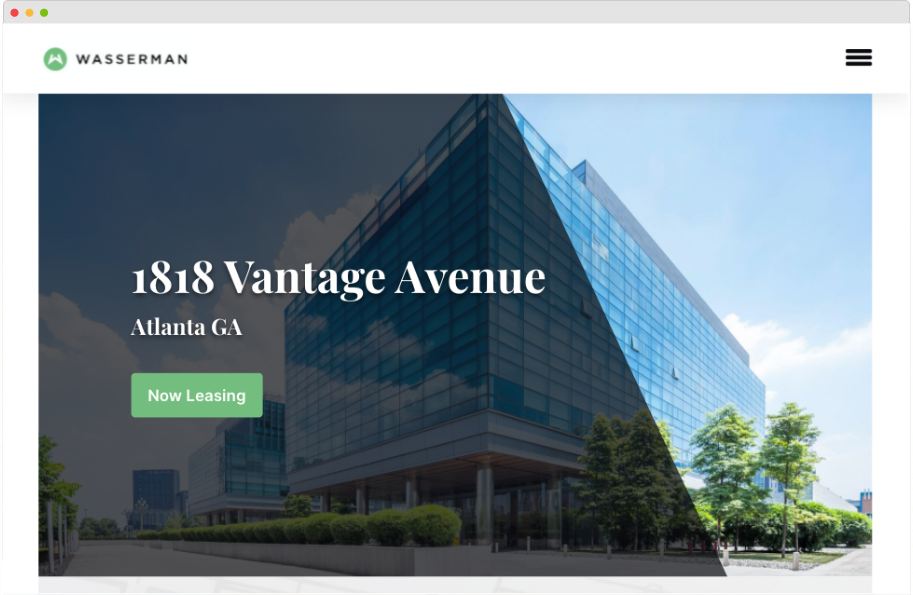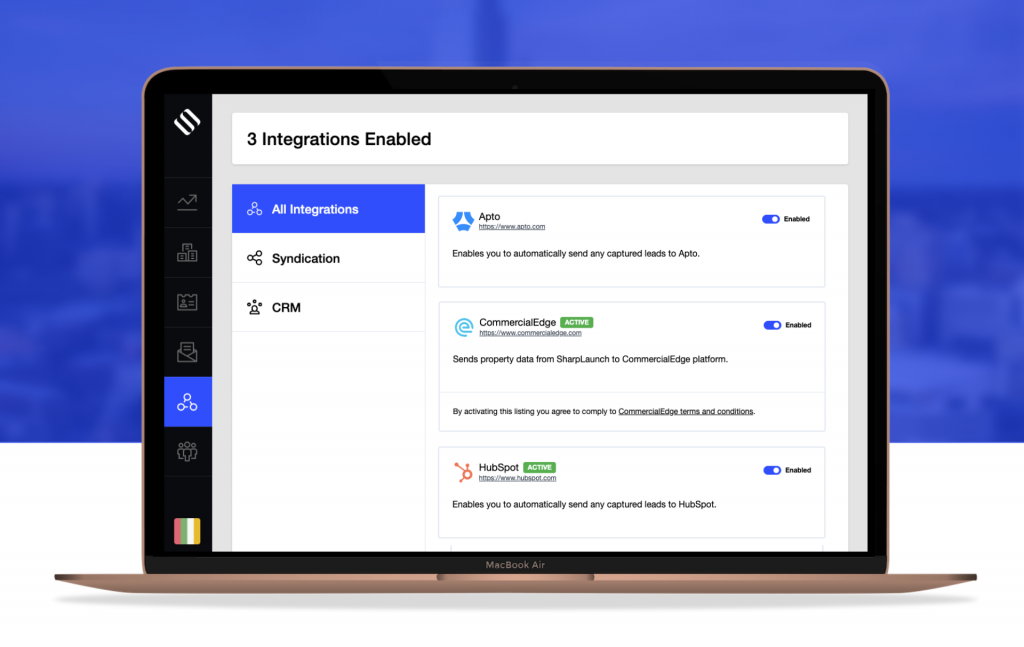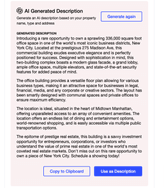
Marketing Best Practices
7 Commercial Real Estate Marketing Trends To Expect In 2024
From building an integrated marketing stack to embracing the accelerated uptake of interactive tools, digital marketing materials, and AI, several trends have begun to establish themselves that will influence how companies approach commercial real estate marketing in 2024.
In this article, we’ll cover six of the most significant marketing trends that will impact the commercial real estate industry and how CRE firms operate as we continue through 2024 and the following years.
Here are 6 marketing trends happening right now that all commercial real estate teams need to consider:
1. Print Collateral Continues to Phase Out
The trajectory is clear: the digital wave is reshaping CRE marketing. Embracing this shift toward digital platforms allows for a more dynamic, cost-effective, and environmentally conscious approach to property promotion. As the industry evolves, the dominance of digital marketing over print collateral in real estate marketing seems inevitable.
The creation of digital assets is now simplified and different marketing platforms allow for fast set up and publishing of high quality property websites, digital presentations, virtual tours and other assets that keep potential clients engaged.

Print collateral, once the cornerstone of property promotion, is steadily making way for its digital counterpart. Here’s why:
- Instant Accessibility: Digital platforms offer instant access to information. Property listings, high-resolution images, virtual tours, and comprehensive details are available at the click of a button. Unlike print materials, which have limitations in space and time, digital avenues allow potential buyers or tenants to explore properties at their convenience, from anywhere in the world.
- Cost-Efficiency: Printing and distributing physical brochures, flyers, or catalogs incur significant costs. On the contrary, digital marketing significantly reduces these expenses. With the proliferation of social media, email marketing, and dedicated property websites, the cost-effectiveness of digital marketing surpasses that of print collateral.
- Enhanced Engagement and Interactivity: Digital marketing allows for dynamic and interactive content. High-quality videos, virtual tours, 3D renderings, and immersive experiences captivate audiences far more effectively than static print materials. The ability to engage potential buyers or tenants on a more personal level amplifies the impact of digital marketing strategies.
- Measurable Analytics and Targeting: Digital platforms provide robust analytics and targeting capabilities. Real-time data on user engagement, website traffic, click-through rates, and demographic information enable marketers to refine strategies, target specific audiences, and optimize marketing campaigns for better results—a feature print collateral cannot offer.
- Environmental Impact: As sustainability becomes a focal point across industries, the reduction in printed materials aligns with eco-friendly practices. Embracing digital platforms minimizes paper usage, reducing the environmental footprint associated with print production and distribution.
2. AI Becomes a Dominant Force
As AI (artificial intelligence) continues to evolve, its role in reshaping the commercial real estate marketing landscape will become increasingly significant. Embracing this technological shift is crucial for industry players aiming to stay ahead in a rapidly changing market environment. AI is not just a trend; it’s a transformative force that will redefine how commercial real estate is marketed, bought, and sold in the years to come.
AI will revolutionize the way commercial properties are marketed, creating efficiencies, enhancing decision-making, and providing a competitive edge. Here are a few use cases:
- Data-Driven Insights: AI algorithms can process vast amounts of data and generate actionable insights. By analyzing market trends, demographics, consumer behavior, and property-specific data, AI empowers marketers to make informed decisions. This data-driven approach enables more targeted and personalized marketing strategies, optimizing the reach and impact of campaigns.
- Enhanced Customer Experience: AI-powered chatbots and virtual assistants are reshaping customer interactions in real estate. These intelligent systems can engage with potential tenants or buyers, providing instant responses to queries, scheduling property viewings, and offering personalized recommendations based on preferences. This not only streamlines the customer experience but also frees up human resources for more complex tasks.
- Predictive Analytics: AI algorithms can forecast market trends and property demand with remarkable accuracy. By analyzing historical data and identifying patterns, AI can predict future property hotspots, investment opportunities, and potential risks. This empowers real estate professionals to make proactive decisions and adapt their strategies accordingly.
- Optimized Marketing Campaigns: Machine learning algorithms can analyze audience behavior and preferences, optimizing ad placements and content delivery for maximum impact.
3. Utilizing ChatGPT: The CRE Marketing Trend of 2024
In 2024, ChatGPT will revolutionize CRE marketing by offering extremely efficient and personalized engagement. With its advanced AI capabilities, ChatGPT can handle a combo of tasks such as generating compelling property descriptions, creating tailored marketing campaigns, and providing instant responses to client inquiries. This not only saves time for brokers and marketing teams but also ensures a consistent and professional tone across all communications. As the demand for digital transformation in the commercial real estate sector grows, using ChatGPT will become a key trend, enabling businesses to enhance their marketing efforts and stay competitive.
4. Adoption of Fully-Integrated Marketing Software
Another trend that commercial real estate is experiencing is the increased use of specialized “all in one” commercial real estate marketing tools and its integration with other tech tools, creating an API-driven tech stack that helps you optimize the marketing processes throughout the property lifecycle.

The ability of integrating distinct technology into one stack has allowed for a streamlined flow of listing data from a CRM to content management systems, enabling listings to be published in seconds, syndicated to listing portals with a click of a button and sent out as an email campaign to clients.
What’s more important this synergy has greatly accelerated the speed of dissemination, ensuring up-to-date information is available 24/7.
Tips:
- Consider adopting marketing tools that offer open integrations with other technology
- Reevaluate your current tech stack considering inefficiencies and tools that don’t play well together
- Improve workflows and processes that work, making your efforts repeatable and scalable
5. Rise of Interactive Tools
The ability to engage, empower, and facilitate informed decision-making through interactive tools will not only enhance the customer experience but also set forward-thinking CRE firms apart in a competitive market. As technology continues to evolve, embracing these interactive tools will be pivotal in shaping the future of commercial real estate marketing.
As we continue through 2024, the integration of interactive tools into marketing strategies is poised to reshape the industry.

There are a range of interactive tools that commercial real estate firms are incorporating into their daily marketing schemes:
- Interactive Property Sites – Replacing brochures and flyers, teams can build interactive listing presentations created for the optimal client digital experience. These sites allow user tracking and visitor reporting as part of a digital suite and can be easily shared on other digital channels to generate visibility.
- Interactive Maps – Instead of visiting a site in person, a client will be able to interact with a base map of the property, exploring and gaining insight without having to leave their home.
- Virtual Tours – Long gone are the days of scheduled tours. Now, a client can navigate through a property on a virtual tour, gaining all the information they need through this digital platform.
- Document Portals – All the information a client will need is in one, easy-to-find location, this interactive element allowing clients to download any documents they may need right onto their device.
The movement to these digital futures is a shift that underpins the majority of commercial real estate marketing trends, allowing clients to access information faster than ever before, browse in their own time, and for CRE firms to streamline virtual communication by using interactive elements.
6. Emphasis on Data Privacy and Security
As the digital landscape continues to expand in the realm of commercial real estate, a trend set to dominate strategies in 2024 is the prioritization of data privacy and security. With increasing reliance on digital tools and data-driven decision-making, safeguarding sensitive information has become paramount for establishing trust and credibility in the industry.
Here’s why data privacy and security will shape marketing endeavors in commercial real estate in the coming year:
- Evolving Regulatory Landscape: Regulatory frameworks around data protection are continually evolving. Compliance with standards such as GDPR, CCPA, and emerging local regulations is imperative. Marketing strategies will emphasize adherence to these guidelines to build trust among clients and stakeholders.
- Consumer Expectations: Clients and tenants are becoming more conscious of how their data is handled. They expect transparency, ethical data practices, and assurances of data security. Real estate firms that prioritize and communicate robust data protection measures will gain a competitive edge.
- Risk Mitigation and Reputation Management: Data breaches and mishandling of sensitive information pose significant risks. Real estate marketers will focus on showcasing stringent security protocols, encryption measures, and data handling procedures to mitigate these risks and safeguard their reputation.
- Trust as a Competitive Advantage: Trust is a cornerstone of successful business relationships. Highlighting strong data privacy and security measures will be a key differentiator, fostering trust among clients and setting businesses apart in a crowded market.
- Investment in Cybersecurity Infrastructure: Real estate firms will allocate resources towards robust cybersecurity infrastructure. From encrypted communication channels to secure databases, these investments will not only protect sensitive data but also serve as a marketing point of assurance.
7. Harnessing Data and Analytics
The landscape of CRE marketing is being transformed by the power of data and analytics in 2024. By harnessing advanced data tools, CRE professionals can gain insights into market dynamics, tenant behaviors, and property performance. This data-driven approach allows for more strategic decision-making, enabling businesses to optimize their marketing efforts, tailor campaigns to target specific audiences, and predict future trends with greater accuracy. As the industry moves towards a more analytical framework, those who adopt these technologies will gain a significant competitive edge.
Real-time data analytics enable CRE marketers to track and adapt to market conditions as they evolve. This ensures that marketing strategies remain effective, enhancing the ability to attract and retain clients. By leveraging comprehensive data sets, companies can identify opportunities for growth, improve ROI on marketing spend, and provide clients with insights. The integration of data and analytics into CRE marketing is not just a trend but a fundamental shift towards smarter, more efficient business practices that will define the industry’s future.
Final Thoughts
As we navigate through 2024 and beyond, the commercial real estate landscape is undergoing significant transformations driven by digital innovation and evolving consumer expectations. From the gradual phasing out of print collateral to the emergence of AI as a dominant force and the integration of interactive tools, the marketing strategies employed by CRE firms are evolving rapidly.
By understanding and focusing on complying with marketing trends, commercial real estate firms are able to deliver exactly what their clients are seeking – no matter how complex.
Related Blog Posts
CRE Technology
5 Reasons Why Salesforce Needs a CRE Marketing Platform
Salesforce isn’t only the most widely used CRM, it’s also the leading choice in the...
Company updates
Streamline Your Outreach with Tag-Based Email Campaigns
We are thrilled to announce the launch of our new Tag-Based Email Campaign feature, designed...
Company updates
SharpLaunch Announces New Integration with LandSearch
We’re excited to announce a groundbreaking integration with LandSearch, a prominent online...




